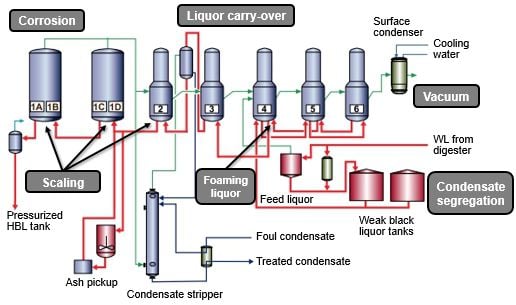Six problems in the evaporator stage and possible solutions
Jul 2, 2019
Evaporators are used to evaporate black liquor from approximately 15% dry solids to 70-85% dry solids. As the dry solids percentage is raised, volatile compounds are released from the black liquor and separated from the condensate, which then gets collected for reuse in the mill reducing the demand for incoming water. Generally, the volatile compounds are incinerated in the gas form in kilns, boilers or stand-alone incinerators. More recently, processes for producing sulfuric acid or low-odor methanol have been introduced, including patented technologies by Valmet.

Six problems inherent in the evaporator stage of the black liquor recovery process
Like all pulp mill unit operations, evaporators can have operating issues due to the processes occurring inside the system or due to the complex mill chemistry. Almost all these issues fall into six main categories including scaling, corrosion, liquor carry-over, vacuum issues, condensate segregation and foaming liquor.
A white paper found HERE, reviews each of these six evaporator issues and suggests process and technology changes that will help mitigate them. Valmet's TUBEL concentrator addresses scaling, as does the mixing of ash, heavy black liquor (HBL) recirculation and on-demand washing. Corrosion is addressed by using 304L SS and duplex alloys in appropriate areas. Avoiding liquor carry-over is primarily a design issue relating to optimized vapor flow and entrainment separators. A properly designed condenser will limit forcing velocities and help vacuum equipment performance. Internal condensate treatment (ICT) and the effective use of the stripping column will improve condensate segregation. Foaming is reduced by any of several means, and multiple simultaneous control solutions can be used.
For more information on improving your evaporator process, contact your Valmet representative.